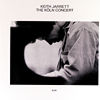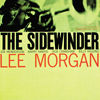| Columns Retired Columns & Blogs |
40 Years of Stereophile: The 40 Essential Albums JAZZ
JAZZ
MILES DAVIS: In a Silent Way
Columbia (1969)
One of the strangest aspects of Miles Davis' transition from acoustic to electric sound is the notion that he "sold out"—that somehow, while making the music more accessible, he also made it less intellectually dense. If anything, his electric period, which began in earnest with these sessions, was more forbidding, and his style more concentrated, than it had been before. Heretical as it may be, In a Silent Way gets the nod here over the more famous Bitches Brew from the same year, because here is where Miles began his electric phase. Even more important, where Bitches Brew is all noisy edges and there's often a terse quality in Davis' tone and approach, In a Silent Way still highlights the beautiful side of his playing. Here introspection, not his dark side, still holds the power.
 ORNETTE COLEMAN: New York is Now!
ORNETTE COLEMAN: New York is Now!
Blue Note (1968)
Eight years past his landmark period of The Shape of Jazz to Come and Free Jazz (both 1960), saxophonist Coleman cut this album with a trio that, besides sax man Dewey Redman, included bassist Jimmy Garrison and drummer Elvin Jones: the last rhythm section of John Coltrane, who had died the year before. While New York is Now! lacks the surprise, inventiveness, and impact of those earlier splashes of sound, it's the sound of Coleman consolidating his earlier stylistic leaps to inexorably become one of the leaders of the music. His 1977 session, Dancing in Your Head, with his electric band Prime Time, is a close runner-up for Coleman's Best Album of the Last Four Decades, but such tracks here as "Garden of Souls" are the sound of a master growing more masterful.
 JOHN COLTRANE: Ascension
JOHN COLTRANE: Ascension
Impulse! (1965)
While the more approachable A Love Supreme is often cited as one of the top two or three most influential records in the history of jazz, Ascension is unlike any other record in jazz, in that the sounds of what was being played took precedence over the actual notes. Although still based on a head-and-solo pattern, this enormously complex, almost incomprehensibly influential album attempts to fuse the ways of jazz's past with its future of free improvisation. Vast oceans of improvisation are interspersed with just enough theme to tether the explorations to earth. While Coltrane's rhythm section of Jimmy Garrison and Elvin Jones distinguish themselves, saxophonist Archie Shepp and Pharoah Sanders provide the fire. Its "free" nature has made Ascension an object of derision among fans of more traditional jazz and a touchstone for true Trane believers.
 KEITH JARRETT: Köln Concert
KEITH JARRETT: Köln Concert
ECM (1975)
The great popularity of this solo album, which put pianist Keith Jarrett and label ECM on the map, did not prevent Köln Concert from being one of the least understood albums of its and our times. Rockers and New Agers thought it was jazz, which it isn't, except sometimes; jazzers thought it was New Age or sentimental pop, which it never is; while classical listeners, if exposed to it at all, were blown away by Jarrett's breadth of association and awesome technique. With this single concert, wholly improvised by a consummate pianist equally at home in the classical, folk, jazz, pop, and standards idioms, Jarrett brought a whole new genre to full flower. Yes, you can use it for background music. Don't.—Richard Lehnert
 JOE LOVANO QUARTETS: Live at the Village Vanguard
JOE LOVANO QUARTETS: Live at the Village Vanguard
Blue Note (1996)
A live album from New York's Village Vanguard has become a rite of passage for jazz players. Here Joe Lovano, the dominant tenor saxophonist of his generation, claims his bit of history with a two-disc set recorded in 1994 and 1995. He cements the spectrum of his abilities by recording with both bop-mainstream and avant-jazz quartets. The first quartet, playing what Lovano calls "collective dialogues," includes the great trumpeter Tom Harrell, who contributed "Sail Away" to the program of seven tunes, four of them Lovano originals. The second, more traditional session, recorded almost a year later, includes tunes by Mingus, Coltrane, and Monk, played by Lovano, pianist Mulgrew Miller, bassist Christian McBride, and drummer Lewis Nash. Lovano's huge tone and buoyant ideas mark him as one of the few of the current generation of jazz players who is adding something new to the music.
 LEE MORGAN: The Sidewinder
LEE MORGAN: The Sidewinder
Blue Note (1963)
Jazz purists may run it down as being too predictable and accessible, but the 24-bar theme of trumpeter Lee Morgan's title tune—certainly not the most complex jazz head ever written—has grown no less hummable than it was 39 years ago. "Hocus Pocus" and "Totem Pole," more Morgan originals, prove that his compositional skills extended beyond the title cut. With solid support from saxophonist Joe Henderson and pianist Barry Harris, the album was a hit and a best-seller—something that occurs far too rarely in jazz. Although known for the upbeat side he showed to great effect on "The Sidewinder," by the end of his life Morgan had also developed a moody, introspective side that made him a more complete player. And while he was a leader on 25 dates, his playing as a sideman on over 100 sessions make him one of the trumpet's most influential exponents.
 WAYNE SHORTER: Speak No Evil
WAYNE SHORTER: Speak No Evil
Blue Note (1967)
Almost with the flip of a coin, any number of albums tenor saxophonist Wayne Shorter cut in the 1960s and early '70s (Native Dancer) could be chosen as his most influential or accomplished. Recorded while he was part of Miles Davis' second great quintet, Speak No Evil is the choice for two reasons: the stellar quintet of Shorter, trumpeter Freddie Hubbard, pianist Herbie Hancock, bassist Ron Carter, and drummer Elvin Jones; and the lyrical flow of Shorter's playing. No longer the cipher of Rollins and Coltrane that many dismissed him as, here Shorter steps out stylistically and, especially, as a composer—all six tunes are his.
- Log in or register to post comments




































